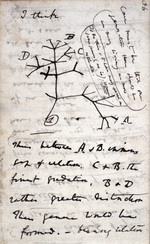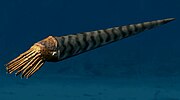the Cambrian, cephalopods are most common in shallow near-shore environments, but they have been found in deeper waters too. Cephalopods were thought to... 34 KB (3,863 words) - 17:56, 22 March 2024 |
 | Evolution is the change in the heritable characteristics of biological populations over successive generations. It occurs when evolutionary processes... 238 KB (24,700 words) - 04:40, 1 April 2024 |
 | Orthoceras (redirect from Orthoceras (cephalopod)) Orthoceras is a genus of extinct nautiloid cephalopod restricted to Middle Ordovician-aged marine limestones of the Baltic States and Sweden. This genus... 5 KB (437 words) - 18:48, 12 January 2024 |
 | Plectronoceras (category Cambrian molluscs of North America) of cephalopod evolution", in Wilbur, Karl M.; Clarke, M.R.; Trueman, E.R. (eds.), The Mollusca, vol. 12. Paleontology and neontology of Cephalopods,... 3 KB (213 words) - 10:37, 20 March 2024 |
 | Orthocerida (category Mesozoic cephalopods) Orthocerida, also known as the Michelinocerida, is an order of extinct orthoceratoid cephalopods that lived from the Early Ordovician (490 million years ago)... 10 KB (1,019 words) - 11:12, 24 December 2023 |
 | Ammonitida (category Cephalopod orders) Ammonitida or "True ammonites" are an order of ammonoid cephalopods that lived from the Jurassic through Paleocene time periods, commonly with intricate... 3 KB (204 words) - 01:23, 29 December 2023 |
 | Coleoidea (redirect from Soft-bodied cephalopods) (August 2011). "Cephalopod origin and evolution: A congruent picture emerging from fossils, development and molecules: Extant cephalopods are younger than... 9 KB (831 words) - 12:51, 22 March 2024 |
 | Nautiloid (category Paleozoic cephalopods) Nautiloids are a group of marine cephalopods (Mollusca) which originated in the Late Cambrian and are represented today by the living Nautilus and Allonautilus... 37 KB (3,438 words) - 16:06, 13 February 2024 |
 | Ammonoidea (category Mesozoic cephalopods) Ammonoids are extinct spiral shelled cephalopods comprising the subclass Ammonoidea. They are more closely related to living coleoids (i.e., octopuses... 49 KB (5,527 words) - 23:25, 24 March 2024 |
 | Endocerida (category Ordovician cephalopods) a group of cephalopods from the Lower Paleozoic with cone-like deposits in their siphuncle. Endocerida was a diverse group of cephalopods that lived... 13 KB (1,355 words) - 03:42, 3 December 2023 |
 | Plectronocerida (category Prehistoric cephalopod orders) shelled cephalopods, plectronocerids had a tube called a siphuncle, which let them fill the chambers of their phragmocone with gas instead of water, thus... 4 KB (424 words) - 09:36, 14 February 2023 |
 | Nautilida (category Paleozoic cephalopods) Teichert, T. (1988) "Main Features of Cephalopod Evolution", in The Mollusca vol. 12, Paleontology and Neontology of Cephalopods, ed. by M.R. Clarke & E.R. Trueman... 10 KB (1,127 words) - 17:26, 3 December 2023 |
bestseller by Peter Godfrey-Smith on the evolution and nature of consciousness. It compares the situation in cephalopods, especially octopuses and cuttlefish... 14 KB (1,560 words) - 16:47, 25 November 2023 |
Ellesmerocerida (category Cephalopod orders) The Ellesmerocerida is an order of primitive cephalopods belonging to the subclass Nautiloidea with a widespread distribution that lived during the Late... 8 KB (890 words) - 16:20, 14 January 2024 |
 | Orthoceratidae (category Prehistoric cephalopod families) Orthoceratidae is an extinct family of actively mobile carnivorous cephalopods, subclass Nautiloidea, that lived in what would be North America, Europe... 3 KB (278 words) - 09:43, 5 September 2021 |
Permoteuthis (category Prehistoric cephalopod genera) genus of belemnite, an extinct group of cephalopods. Paleontology portal Belemnite List of belemnites Sepkoski, Jack (2002). "A compendium of fossil... 842 bytes (42 words) - 01:23, 29 April 2021 |
 | The evolution of cetaceans is thought to have begun in the Indian subcontinent from even-toed ungulates (Artiodactyla) 50 million years ago (mya) and to... 81 KB (9,674 words) - 21:47, 13 March 2024 |
Turcutheca (category Cambrian animals of Europe) ellesmeroceratids (early cephalopods). Dzik, J. (2010). "Brachiopod Identity of the Alleged Monoplacophoran Ancestors of Cephalopods". Malacologia. 52 (1):... 1 KB (119 words) - 04:09, 2 August 2021 |
 | Squid (redirect from Evolution of squid) called squid despite not strictly fitting these criteria. Like all other cephalopods, squid have a distinct head, bilateral symmetry, and a mantle. They are... 67 KB (6,853 words) - 08:04, 8 April 2024 |











